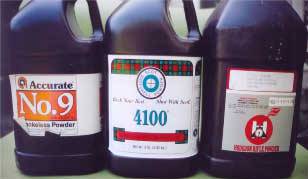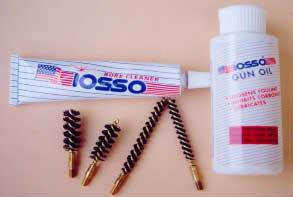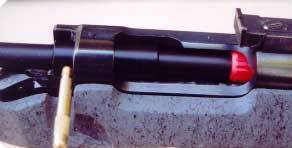|
You might remember that in last monthís column I did a review of a
Freedom Arms
prototype silhouette style gun case. I explained that the folks in
Freedom Wyoming were thinking about offering a lower priced gun case that
retained almost all of the features of their regular Expedition model. I then
asked you, the membership, to e-mail me with your comments both pro and con as
to whether you thought Freedom should produce the case or not. Well the results
are in and are as follows.
-
Number of people in favor of the new case
0
- Number of people against the new case
1
So, I guess you could say that 100% of the respondents were against
the new case. As promised, the results have been forwarded to Freedom Arms.
Three Fast Balls - During the course of reloading for a fair number of different
cartridges, Iíve noticed that three of the powders that I use fairly regularly
for the 357 mag seemed to be very, very similar to each other. They are Accurateís #9, Accurateís 4100, and Hodgdonís H108. All are ball types suitable
for magnum pistol applications. All are extremely fine grained which makes them
remarkably easy to meter, and all have a somewhat faster burning rate than H110
or WW296. Even the color of all three is very similar. I couldnít help but
wonder if perhaps all three might be really the same powder under different
labels. I seriously doubted it, but ... It then suddenly occurred to me that
that I had never done a direct comparison of these powders with each other. So,
being curious, I thought "Why not now?"
I also had on hand a small supply of Leadheadís 180 grain 357 bullets
which would be perfect for the experiment. As you know, Iím a big fan of
Leadhead products. If you like shooting cast lead but donít have the time or the
equipment to do the casting, Leadhead products are the best on the market. There
is none better.
One of the key elements for the accuracy and on target performance of Leadhead products is the fact that the secret alloy they use is very tough but
not so hard that it wonít compress and fill the bore when theyíre fired. The
result is no gas blow-by and no leading. Thereís also the high level of attention
to detail that goes into their manufacture. Most other commercially cast bullets
that Iíve seen were enviably made with lead that wasnít properly fluxed and
which were improperly cast at incorrect temperatures. The result is a dirty
looking bullet with plenty of easily seen defects. If they look that way on the
outside, I can imagine that itís very likely that their internal structure
contains plenty of destabilizing and accuracy robbing voids as well.
The Leadhead 180 grain bullet is the RCBS design which is one of the
best on the market. Up to now, I haven't had a chance to really check out
Leadheadís version of this bullet, so this would be a perfect opportunity.
Leadheads Bullets
I decided to use a moderate load i.e. 14.6 grains of each in Starline
Since these three powders are relatively fast burning for their class,
brass.
Ignition would be provided by CCI small pistol magnum primers. The idea would be
to chronograph velocities and check the accuracy of each at 50 yards. I would be
using my Freedom Arms 357 equipped with a Leupold 2X8 scope and rings as the
test bed.
|

|
|
"All three powders had
identical volume to weight ratios." |
|
First I set my Redding BR powder measure to drop 14.6 grains of #9 and
filled ten cases. I then replaced with powder with 4100 and threw a test drop
and weighted it. 14.6 grains right on the nose. The volume to weight ratio was
exactly the same as the #9. That was weird. So I filled up ten more cases. Now
the same procedure for the H108. Again it dropped 14.6 grains exactly. This was
now down right spooky. The volume to weight ratio for all three powders was the
same! Now I really, really began to wonder if they were all actually the same
powder with different labels. Well only the range results will tell the real
story.
Thereís another little twist to this story. As an experiment, I
decided to use a taper crimp rather than a traditional roll crimp on the brass
to see what effect it would have. Thereís plenty of silhouette shooters using
the Ken Light load with a 200 grain spire point with a taper crimp but I donít
know of many cast bullet shooters using taper crimps, so I thought Iíd give it a
try. Hereís the results. All groups were shot at 50 yards.
I thought the results from all three powders were outstanding. I
wouldnít put too much emphasis on the differences in the groups as they probably
reflect just how well I was able to hold at that particular time. The results
are for all practical purposes identical. #9 did show a definite velocity
advantage but all the loads delivered good performance that wouldnít have any
problem taking down the 200 meter targets.
|
POWDER |
PRIMER |
VELOCITY |
SD |
GROUP |
|
14.6 gr. AA #9 |
CCI MAG |
1493 fps |
7 fps |
.75"
|
|
14.6 gr. AA4100 |
CCI MAG |
1425 fps |
3 fps |
.50" |
|
14.6 gr. H108 |
CCI MAG |
1448 fps |
7 fps |
.88" |
So are these three powders actually the same product? I still donít
think so, but with 14.6 grains in the case, theyíre very, very similar and
thatís actually a good thing. Having choices is always good.
LBT Returns - Veral Smithís Lead Bullet Technology company has quietly returned on
the scene and is once again producing high quality bullet molds and other
products. I donít know of anyone that has used one of his molds or shot the
bullets that they produce that haven't sung their praises. LBT Blue and LBT Blue
Soft bullet lube have also received high marks from cast bullet shooters as
well. They also produce the only lead hardness tester available to amateur
casters that gives direct readings in Brinell numbers. Other testers give
readings that then have to be converted into Brinell numbers. Contact them at
(LBTisAccuracy@imbris.net)
and request a copy of their very informative catalog. Itís full of great
information and just about all aspects of cast bullet making.
50 Smith & Wesson - This gun has certainly made a big impression around the country after
its spectacular introduction at this yearís Shot Show. The nuts who run the city
of Los Angeles wasted no time banning sales of the big revolver even though
police officials publicly stated that because of its size, that the gun was
almost impossible to carried in a concealed manner.
However, all the controversy made me kind of curious about what a
typical hand load for the big fifty might be, so I started calling around to my
industry friends to see what they knew. I finally dug up the following
unofficial info and thought you might be interested.
|
Bullet |
465 grain LeadHead cast |
|
Powder |
40.2 grains of Hodgdon Lil Gun |
|
Primer |
CCI 350 |
|
Velocity |
1648 fps (ouch!) |
|
Pressure |
44,300 psi |
The most interesting part of the load info was the fact that Starline
was making the brass. This load penetrated a block of grade 3 ballistic gelatin
to a depth of over 21 inches. I guess itíll take rams, but Iíd hate to shoot
forty of them.
More on the Redding Competition Seating Die - As you know I recently wrote a two part series on the reloading
techniques used by Rick Kelter of the Los Angeles Silhouette Club to produce
very high quality cast bullet loads. During my reloading trials, I varied his
technique of rotating the case during the bullet seating operation by using a
Redding Competition Seating Die instead.
After reading my articles, Rick was somewhat curious about whether
the Redding die could beat his tried and true bullet seating method. By checking
bullet run out with a dial gauge, he knew that with his method, run-out fell
between .001 and .004" with the preponderance of the readings running around
.003" inches. With the Redding die, the bulk of the bullet run-out readings are
now in the 1 - .002 inch range - a real improvement.
Surprisingly, he also found
that the Redding die also reduced bullet seating depth variation by .004 of an
inch. As Rick pointed out, that can have a direct impact on pressures, velocity,
and bullet drop. Thatís something that neither he nor I expected. The bottom
line is that the Redding Competition Seating Die really does a measurably
superior job of bullet seating. So if youíre serious about your silhouette
shooting, you need to consider acquiring one at the first opportunity. See
"Redding Reloading" complete line on the web.
http://www.redding-reloading.com
|

|
|
"Iosso
produces a wide array of gun
and case cleaning products that have established a solid reputation for
performance." |
|
Iosso Gun Cleaning System -
If thereís one thing that my friends have heard me say more often than
anything else itís "A clean barrel is a more accurate barrel." Heck, theyíll
probably put it on my gravestone. However, itís true.
I know thereís tons of shooters out there that clean their guns maybe
once a year at the end of the season, if that much, and they all say "My gun
shoots just fine without all that messing around." But does it really? Theyíre
the same guys that when they miss that shoot-off target will have all kinds of
excuses for the miss like "My socks were too tight" etc.
Then there was the time I was looking at an XP that was for sale at
the Internationals. A quick look down the barrel showed a bore from hell. It was
nothing but caked fouling, pitting, and corrosion from one end to the other.
Jokingly, I asked "How often do you clean this thing?" Thinking I was serious,
the seller replied "Cleaning just wears out the barrel, so I never bother with
it." Mmmmm. "Thatís a new one" I thought. I then asked "What kind of scores does
it shoot?" "Oh, well Iím not really that good of a shot." This is an extreme
case of course, but having a dirty, fouled barrel will have subtle, negative
effects on the accuracy of any barrel, and its longevity as well.
One of the best combination of products available for doing a
absolutely thorough job of cleaning your barrels is the Iosso gun cleaning
system. The system is composed of Isso bore brushes, bore cleaning paste, and
Iosso Gun Oil. (Iíve been using the paste for around 10 years now.) All the
components of the system are sold separately so youíre not locked in to using
them all together if you donít want to. But if you do want the most thorough
cleaning possible, using each component in conjunction with the others is the
best approach. Letís take a quick look at each part of the system.
Iosso Bore Brushes - A new product, these are plastic bristled, which
means that they can be used with ammonia based cleaners without fear that
theyíre going to be eaten up like bronze brushes after only a few cleanings. The
problem with regular plastic brushes is that the bristles are too flexible, so
when theyíre pushed through the bore, theyíre laid way back and so donít attack
the fouling and leading as aggressively as they should for the best cleaning.
The bristles on Iosso brushes are stiffer, and therefore more
aggressive on the fouling. Also because theyíre plastic, thereís never any
danger of scratching or damage to the lands like youíd find with stainless
brushes. So basically the Iosso brushes gives you the performance and resistance
to ammonia of stainless, but without the worry of damage.
Iosso Bore Paste - This very effective
cleaning paste comes in
a tube rather than in a bottle. Tony Boyer, the worldís best benchrest shooter of all time, was recently quoted
as saying he uses Iosso Bore Paste on his guns. There is no stink and there is
no danger of spills, or as I did once, dropping a big bottle of bore cleaner on
the garage floor. What a mess that was! Just smear some on a couple of patches
and run them through. Follow up with a couple of clean patches and thatís it.
Youíll be surprised how well this stuff works.
Iosso Gun Oil - For the very best cleaning job of all, first use a
patch soaked with the oil and run it down the barrel. This will loosen up the
fouling, especially caked up moly which has a tendency to accumulate at the
throat.
Then follow with the bore paste or best of all bore paste on Iosso
brushes then and clean patches. Lastly, treat with the gun oil again for
corrosion protection, especially if you live in a high humidity environment.
Lastly swab out any excess oil with a couple of dry patches. Naturally, the oil
can be used for general lubricating purposes as well.
As noted before, each of these products can stand on
their own, but when used in combination, youíre going to have a very well
cleaned and protected bore that will be able to deliver all the accuracy itís
capable of delivering. Iosso products are sold by
Sinclair International
and other major gun product
dealers.
Stoney Point All-in-One Bore Guide - In last monthís column I covered the importance of bore guides and
discussed those products made for the TC Contender and Encore. Using a bore
guide for our bolt action silhouette guns is just as important. The traditional
problem with bore guides for bolt guns is that theyíre all different. So if you
want one for your XP-100, you have to buy one just for that gun. If you want a
bore guide for one of your rifles, you have to buy one specially made for it
etc. That can add up to a lot of different bore guides kicking around on your
reloading/cleaning bench.
|

|
|
"Extra tapered tips
are provided to fit almost all bore sizes." |
|
Well Stoney Point has solved that situation with its "All-in-One" bore
guide. I guess you could easily call it a universal bore guide that can fit just
about any bolt gun no matter if itís a short, medium, or long action.
The guide is an black anodized hardened aluminum tube with a tapered
plastic nose at one end and a plastic solvent port at the other. In between the
two is a sliding collar that can be moved forward or backwards. A brass knurled
handle about an inch and a half long screws into the side of the collar and acts
as a bolt handle.
|
 |
|
"The Stoney Point
All-in-One bore guide will fit almost any center fire bolt action
receiver including the XP-100." |
|
To install the guide, first remove the bolt from your unloaded gun.
Then insert the guide, tapered nose first, through the action so that the nose
is now pressed firmly into the throat of the barrel. Three different sized
plastic noses are provided to accommodate every caliber form 17 Remington up to
416 Rigby. Now slide the collar with its brass handle over to where the regular
bolt handle would be located in the action. Move the brass pin down into the
bolt lock position and turn it in to snug the collar in place so it wonít move.
The bore guide is now firmly in place. Just insert your cleaning rod into the
bore guide and clean away. Use the solvent port to saturate your brush or
patches with liquid cleaner if thatís what you prefer.
Thereís two big advantages to the All-in-One guide. First is it's
flexibility. This single guide fits just about every bolt action made. The other
is that when the tapered nose piece is pushed into a barrelís throat, it helps
keep dirty solvent from running into the actionís locking lug recesses as well
as back down into the trigger group. If you want to protect your expensive
barrel from unnecessary wear when cleaning, a bore guide is a must, and the Stoney Point is the one you should consider first.
Stoney Point on the web
http://www.stoneypoint.com
|
![]()